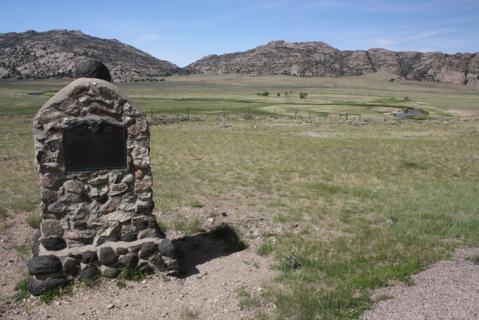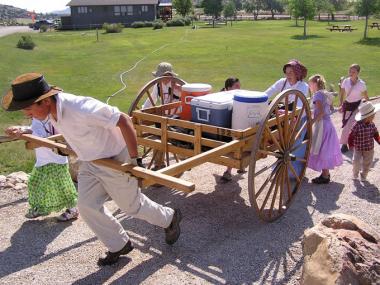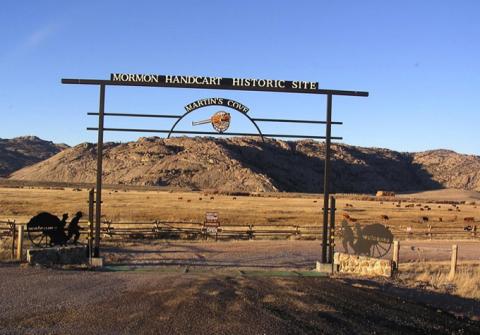- Home
- Encyclopedia
- The Martin’s Cove Controversy
The Martin’s Cove Controversy
Martin's Cove is a sagebrush-covered tract of several hundred acres, surrounded by rocks near Devil's Gate on the Sweetwater River. It is named for the Martin Handcart Company, members of the Church of Jesus Christ of Latter-day Saints who camped there in 1856 during their late-season crossing of Wyoming.

The heroism and tragedy of this journey helped spur Mormon church leaders in the mid 1990s to buy land nearby as a venue for telling the story of the handcart pioneers. In the early 2000s, Wyomingites protested as the LDS church attempted to purchase public land containing the Cove itself. Eventually, a lease agreement settled the controversy.
The handcart tragedy of 1856
The 1856 emigrants—the Willie and Martin companies, numbering more than 1000 people in all—began their crossing to the Mormon settlements in Utah Territory in August. Most pioneer travelers, even those traveling to Utah, only half the distance to California or Oregon, left well before this.
The Willie and Martin companies traveled by handcart, a method regarded by church leadership as faster and less expensive than ox drawn wagons, across Nebraska Territory and into what's now Wyoming, where bad weather struck them.
In mid-October, winter storms halted the Martin company at Red Buttes near present-day Casper, Wyo. and the Willie Company at a place on the Sweetwater River about 100 miles further west, now called Last Crossing. Both companies were eventually found by rescue parties sent east from Utah, and during the rescue effort the Martin Company spent several days camped in relative shelter in the Granite Mountains near Devil's Gate on the Sweetwater.

For many emigrants, though, rescue was too late. Exhaustion, cold and starvation took their toll and before November, when the surviving emigrants reached Utah, death rates have been estimated as around 14% in the Willie company and 25% in the Martin company—figures that marked this journey as the worst non-military disaster on the emigrant trails.
The naming of Martin’s Cove
Only a few more handcart companies crossed the plains to Utah after 1856; the last to do so was in 1860. For two decades or so, the disasters of 1856 received little public discussion in Utah; perhaps the memories were too painful.
In the 1870s, a few accounts of the events of 1856 began to appear in Utah newspapers. As the survivors of those events aged, more began to want to record their memories and many accounts were written down late in the 1800s and after the turn of the century. In these accounts, the cove in the rocks where the Martin Company camped began to be called Martin’s Ravine, or Martin’s Cove.
No one in the Martin Company kept a journal and there is no record of how many people died at Martin’s Cove. The only count of deaths was made by a scout for the rescuers, also written down decades later, of the 56 people who died near Red Buttes. The Willie Company did have diarists; people began dying in the Willie Company not long after that group left Fort Laramie. The same was probably true of the Martin Company.
It’s clear, that is, that people were dying in both companies all across what’s now Wyoming and into Utah. But Mormon storytelling, in subsequent decades, concentrated the dying at Martin’s Cove.
As roads improved and cars became popular in the early decades of the 20th century, there was a general rise of interest in America's pioneer past—and in marking the locations of historical events.
Over the weekend of July 4, 1930, about 200 Mormon pioneers and church leaders from Utah attended a large Oregon Trail Memorial Association event at Independence Rock on the Sweetwater, about 55 miles southwest of Casper. The event drew 600 or more boy scouts from around the nation and local crowds of many thousands.
The following summer, a mostly Mormon crowd of a few hundred gathered again at Independence Rock, and Church President Heber J. Grant dedicated a plaque there honoring Mormon pioneers.
Also on this trip, Church leaders decided that the cove in the rocks about two miles upstream from Devil’s Gate was in fact the place where the members of the Martin Company had camped in 1856—even though contemporary accounts of its whereabouts were sketchy, and no survivors of the 1856 event had ever returned to pinpoint its location.
“Pioneer Trail Group Locates Tragic Refuge,” the Deseret News announced in Salt Lake City at the time. In 1933, members of the Utah Pioneer Trails and Landmarks Association returned and put up a monument, naming the place Martin’s Cove. That monument still stands, next to the old paved highway and across the river from the cove itself.
The Second Rescue
In 1992, several members of the Riverton, Wyo., stake of the LDS Church reminded the church leaders in Utah that many essential church rituals had never been performed for the people who had perished in the Willie and Martin companies. In Mormon doctrine, these ceremonies, including baptism and so-called sealings of departed souls to those of a spouse, or to ancestors or descendants, can be performed at any time. They must be performed in a Mormon temple, however, and the nearest temple to Riverton at the time was in Ogden, Utah, a six-hour drive away.
Volunteers traveled from Riverton to the Ogden temple for the ceremonies. The new interest came to be called the Second Rescue, and stories about it began appearing in the Deseret News and other church publications.

New monuments were dedicated in 1992 at Martin's Cove, which was located on U.S. Bureau of Land Management land leased to the Sun Ranch for livestock grazing.
Negotiations with the Sun Ranch for an access easement across private land soon began, but long before these discussions were complete, Mormon visitors began showing up, wanting to see the site.
A new lease
Eventually, church officials decided they preferred to purchase the property instead of obtaining an easement for access only, and in 1997, owners of the Sun Ranch agreed to transfer 13,000 acres of deeded land around Devil’s Gate to The Church of Jesus Christ of Latter-day Saints. A 5-year lease of Martin's Cove was obtained from the federal Bureau of Land Management, but many in the church hoped to gain outright ownership of the land.
In 2002, Rep. Jim Hansen of Utah introduced congressional legislation to allow the LDS Church to purchase the tract of BLM land containing Martin's Cove. This bill was popular with Utah residents and not controversial nationally, but many in Wyoming opposed it and coverage was heavy in Wyoming newspapers.
"Passage of this bill would create a terrible precedent” opponent Barbara Dobos testified in Casper at a Congressional field hearing on the issue, “for selling off our national historic and prehistoric public sites to select special interest groups by political means." In November 2002, an attorney for the Association on American Indian Affairs told the Casper Star-Tribune that the sale of Martin's Cove would set a precedent for "the purchase by tribes of their own sacred sites on federal lands."
Hansen's bill passed the House but stalled in the Senate, largely because of opposition from Wyoming’s U.S. senator, Craig Thomas. Finally, with Thomas’ backing, a 25-year lease was negotiated between the BLM and the Mormon Church that allowed the church to use the land, establish trails and put up interpretive signs for a fee of $16,000 a year.
The Church now maintains a Martin’s Cove visitor’s center at the former Sun Ranch headquarters, and the facility is staffed full time by volunteer missionaries. Church officials say the center and the cove itself are visited by more than 50,000 people every year, many of them Mormons who come to learn about and gain inspiration from the sacrifices of the handcart pioneers.
Editor’s note: For an account of the handcart tragedy of 1856 click here.
Resources
Primary Sources
- Farquhar, Brodie. "Interior Backs Sale to Church," Casper Star-Tribune May 5, 2002.
- Farquhar, Brodie. "Tribes Look at Martin's Cove Sale." Casper Star-Tribune November 5, 2001.
Secondary Sources
- Rea, Tom. Devil's Gate: Owning the Land, Owning the Story. Norman, Oklahoma, University of Oklahoma Press, 2006. 78-99, 212-233, 248-257
- Roberts, David. Devil's Gate: Brigham Young and the Great Mormon Handcart Tragedy. New York, Simon and Schuster, 2008 121-179
Illustrations
- The photos of the 1933 Martin’s Cove monument, the family with the handcart and the 2007 photo of the gate to the Martin’s Cove historic site are by Tom Rea. The entrance road to the property is now paved.
